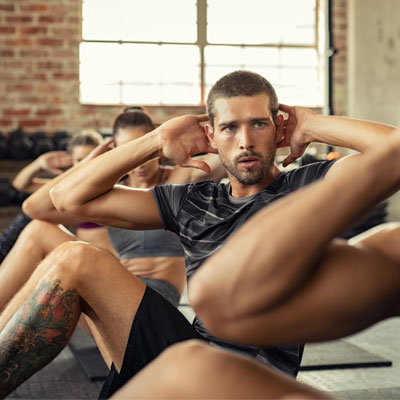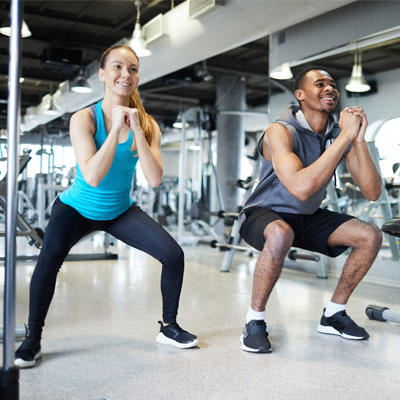Contents
Human growth hormone – HGH – is crucial for building and maintaining muscle mass. However, did you also know that building muscles can help increase HGH levels? The right type of workout can significantly boost your HGH production. What we will explain here about HGH and workout goals will help you maximize your human growth hormone potential.
By the time most adults reach age 30, their HGH production is already on the decline. Somatopause – the term also used to describe growth hormone deficiency (GHD) – can happen to men and women. Just as with menopause and andropause (male menopause – Low T), Somatopause can bring a host of unwanted symptoms. There is something you can do to minimize the effects of GHD and unlock the ability to produce increased amounts of growth hormone.
Your HGH workout needs to include the right types of exercises to maximize GH release. Not all exercise can do this. For example, extended cycles of cardio training can have a reverse effect on critical hormone levels, including HGH and testosterone. If you are the type of person who enjoys an hour on the treadmill or stationary bike, you may actually be unknowingly lowering your hormone levels.
In this report, we will also look at the use of supplement HGH for workout results. Some bodybuilders and athletes swear by the benefits of HGH for their bodies. Can HGH really help improve muscle mass, speed, and strength? Keep reading to find out.
Discover how to maximize your potential by increasing HGH levels by working out with the right type of exercise.
Can Working Out Increase HGH Levels?
The answer here is yes, working out can increase your HGH levels. In fact, high-intensity interval training (HIIT) has been shown to provide the highest boost in HGH production. These HGH workout results have been well documented in numerous studies.
Exercise-induced growth hormone response (EIGR) has been well studied and proves that both resistance training and HIIT can substantially boost HGH production.
One area of continual controversy is whether resting between sets is beneficial. In regard to increasing HGH and workout routines, the no-rest regimen provides a significantly higher boost of HGH levels.
Working out can significantly increase HGH levels.
What Should My HGH Workout Plan Look Like?
There are two different ways in which you can use exercise to increase HGH levels. The first is through resistance training and the second is high-intensity interval training. Both a no-rest (NR) and a with-rest (WR) protocol received testing, with the NR winning out for boosting HGH secretion.
The no-rest HGH workout plan should consist of 3 to 5 sets of 10 repetitions (10-repetition maximum) of compound exercises that work more than one joint and muscle group, such as:
- Shoulder press (triceps, deltoids, back)
- Lat pulldown (back, biceps, pectoralis minor, forearms)
- Bilateral knee extension (quadriceps, traps)
- Pushups (chest, shoulders, abs, triceps)
- Bench presses (chest, biceps, deltoids, lats, quads, triceps)
- Pullups (chest, shoulders, back, biceps)
- Clean and press (all major muscle groups)
- Deadlifts (glutes, back, legs)
- Lunges (calves, quads, hamstrings, glutes)
- Bent over rows (low back, legs, core, biceps, rear deltoids, rhomboids)
Include an interest rest period of 1 minute. Do not take a rest period midway through the exercise sets. Your exercise routine should take no longer than 40 minutes. Working out longer than that could have the reverse impact on HGH levels.
Next up we have the topic of HGH and workout with high-intensity interval training. HIIT sessions should last no longer than 20 to 30 minutes. Limit HIIT workouts to three a week. Choose whichever form of aerobic activity you desire – swimming, cycling, running, stair-climbing, etc. Perform the activity at a moderate pace for two minutes and then increase the intensity to a maximum threshold for 20 to 30 seconds at the most. Repeat this for no more than 30 minutes. HIIT sessions not only maximize HGH release but also improve fat burning and loss.
Both resistance training and high-intensity interval training can help increase human growth hormone levels.
Does HGH Help Speed Recovery After a Heavy Workout?
One of the reasons that some people use a post workout HGH injection (illegally) is to speed recovery. If you follow the guidelines for exercising in the previous section, your pituitary gland will secrete additional HGH to repair muscles damaged by your workout.
The use of HGH for workout recovery or to help build muscle mass is controversial. First of all, HGH is illegal in the sports and bodybuilding worlds. Human growth hormone is considered a form of doping and is banned from use. Second, it is extremely dangerous to the body to increase HGH levels higher than their normal state. No person should use HGH in his or her twenties unless medically necessary. Even in one’s thirties or forties, there should be a medical need for HGH injections before use. Most people still produce enough growth hormone to fuel their bodies until later in life. Only through blood analysis can a deficiency be identified.
Studies have shown HGH to be ineffective for increasing muscle mass and strength in adults with normal growth hormone levels. The only proven benefit is a slight increase in speed. The reason some bodybuilders swear by HGH for muscle increase is because they use it with testosterone. Steroids can increase muscle mass and are the cause of any gain – not HGH injections.
If you are exercising properly, your body should provide you with all the HGH you need. Understanding this fact about HGH and workout efficiency can help you plan for better exercising protocols.
Natural secretion of HGH post-workout can help aid muscle recovery.
Is It Better to Take HGH Injections Before or After a Workout?
We do not recommend using HGH after workout unless medically prescribed by a hormone specialist. For most adults dealing with growth hormone deficiency, the optimal time to take HGH injections is at night. The reason for this is that the body secretes its maximum amount of HGH during sleep. While you are asleep, your body uses HGH to repair damaged tissue, facilitate metabolism for fat burning, and perform critical cognitive functions to process and store all information gathered during the day. By injecting supplemental HGH before bed, you optimize its abilities to perform these duties.
For further information about HGH and workout guidelines and practices, please contact our hormone clinic. We provide free, private consultations by phone to men and women throughout the US looking to restore hormonal balance to their bodies and lives.
- Richard J Godfrey, Zahra Madgwick, Gregory P Whyte
- J. A. Kanaley, J. Y. Weltman, J. D. Veldhuis, A. D. Rogol, M. L. Hartman, and A. Weltman
- Written by Rudy Mawer, MSc, CISSN
- Laurie Wideman, Judy Y Weltman, Mark L Hartman, Johannes D Veldhuis, Arthur Weltman
The exercise-induced growth hormone response in athletes
Human growth hormone response to repeated bouts of aerobic exercise
11 Ways to Boost Human Growth Hormone (HGH) Naturally
Growth hormone release during acute and chronic aerobic and resistance exercise: recent findings








